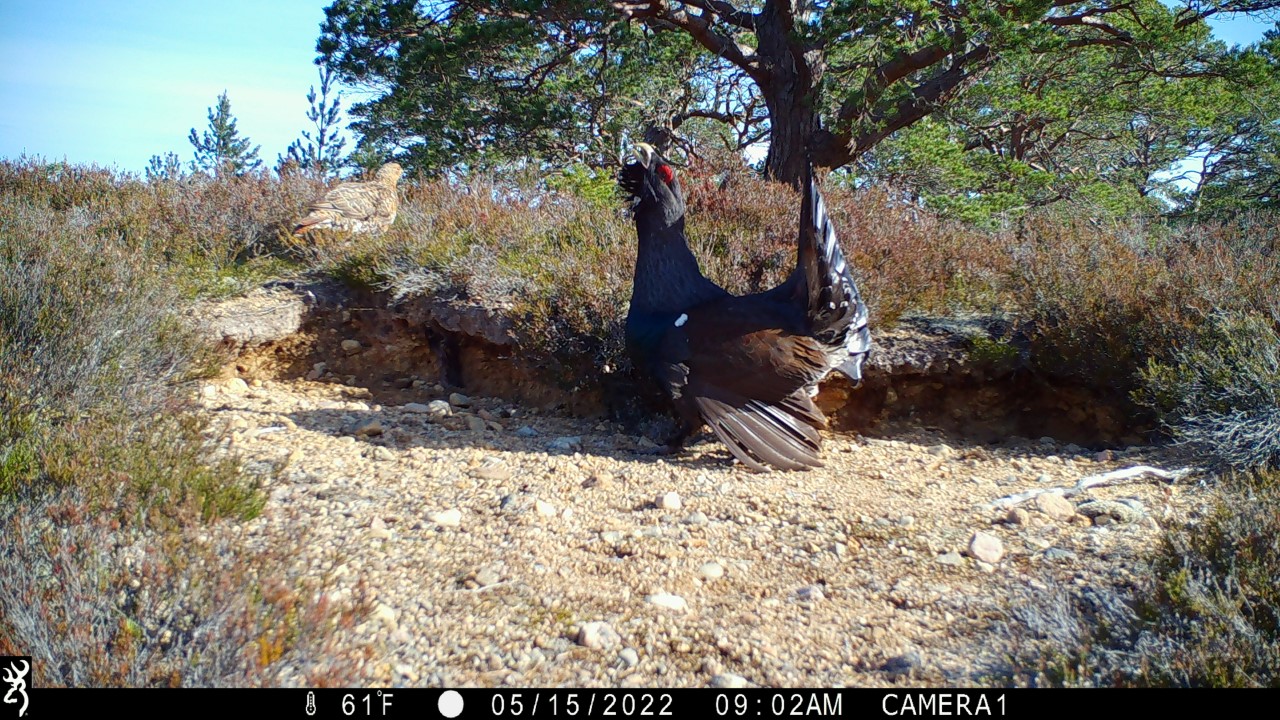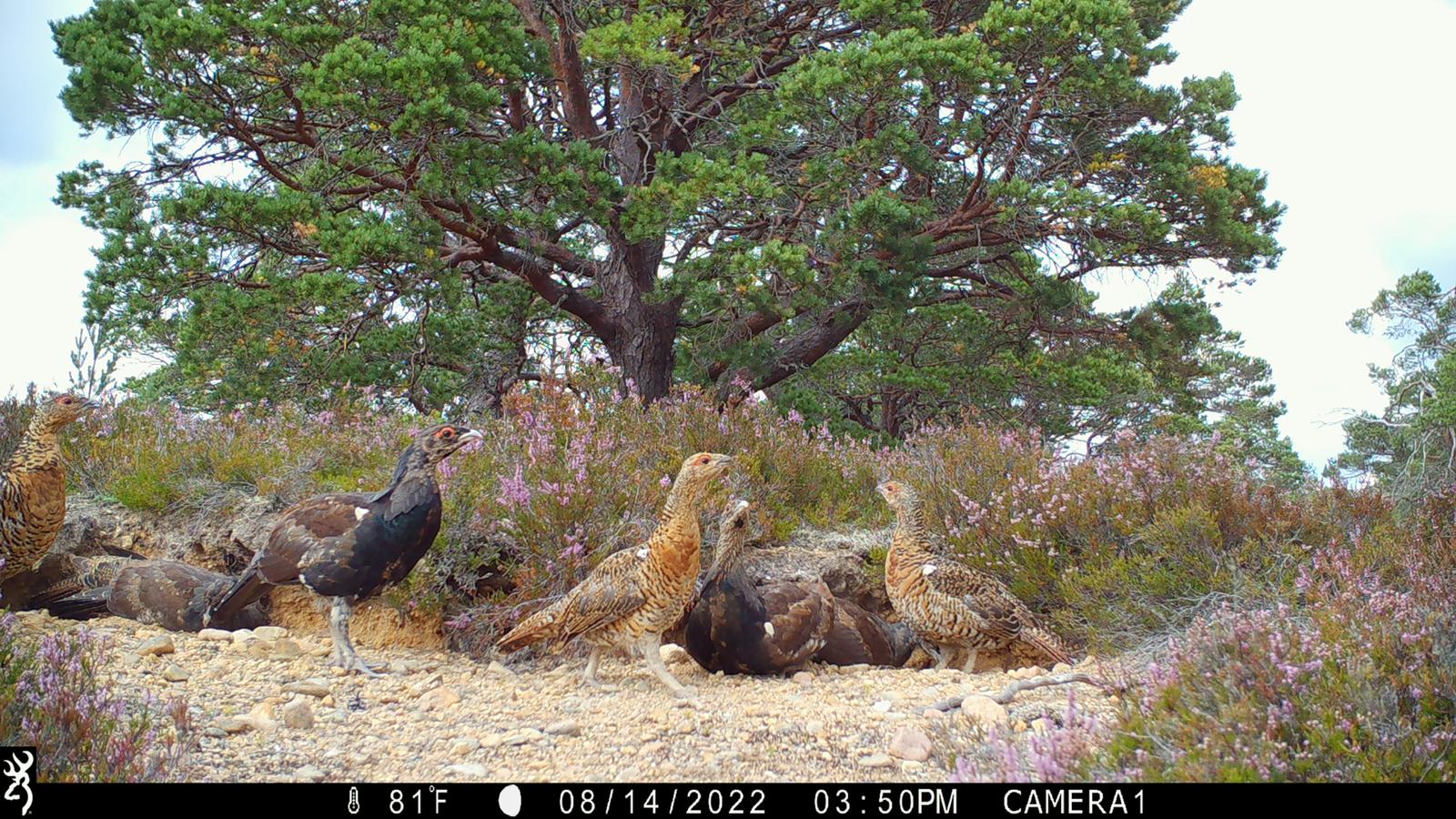

How the Cairngorms Connect Predator Project used camera technology to boost conservation efforts by providing a more accurate capercaillie count in the Highlands.
Inexpensive cameras - dotted across the 60,000 hectares of landscape that forms the Cairngorms Connect Partnership area - have captured over 3000 images and some video of capercaillie and give a more accurate assessment of capercaillie distribution and breeding success in the Highlands.
Forestry and Land Scotland (FLS) placed the cameras in prime locations to help determine whether efforts to improve capercaillie breeding numbers have been successful this year. The images are now being processed and will help the team assess how many capercaillie hatched and survived during the 2022 breeding season, which ran from March to September.
 Image: A lekking male capercaillie.
Image: A lekking male capercaillie.
The work was undertaken by Jack Bamber, a PhD student at the University of Aberdeen who’s been funded by FLS, Wildland Limited and a Natural Environment Research Council (NERC) doctoral training programme. He is monitoring efforts to restore the endangered capercaillie without disturbing the birds.
Jack said: “Traditionally, people used to monitor capercaillie broods by flushing them out with highly-trained pointer dogs. Now, with inexpensive camera technology, we can keep an eye on them without disturbing or distressing them. Humans may like a bubble bath, but capercaillie love to bathe in dust. Their dust baths tend to be in areas of exposed earth, like upturned root plates of trees that have fallen over. They bathe in the dust to get rid of lice and pathogens, and it helps remove excess oil from their feathers, among other things.
“We placed over 80 cameras around dust baths and we’ve now collected over 300,000 images, around 3000 of which contain capercaillie."
 Image: A mature capercaillie brood caught on camera trap within the Cairngorms Connect Partnership Area.
Image: A mature capercaillie brood caught on camera trap within the Cairngorms Connect Partnership Area.
Capercaillie are on the verge of extinction in Scotland. Their numbers have plummeted due to a combination of circumstances, including changes to springtime temperatures and frequently wet summers which depress breeding and chick survival. Capercaillie also fly into deer fencing and are sensitive to disturbance, so tend to avoid even good habitat if it’s within 100m of tracks or paths.
Land managers and organisations like FLS have put special management procedures in place to try to protect them, like removing deer fencing in forests with capercaillie, or making fences much more visible.
Predators such as foxes and pine martens can reduce capercaillie breeding success. As part of the Cairngorms Connect Predator Project, food for the capercaillie’s predators is tactically placed in the landscape in a bid to distract and satisfy the predators, in order to keep capercaillie nests and chicks safe. This diversionary food is only left out for a short period of time when capercaillies are incubating eggs and rearing small chicks. The short time period reduces the likelihood of increasing the number of predators.
Kenny Kortland, FLS wildlife ecologist and lead of the Cairngorms Connect Predator Project, explains: “We’ve been leaving deer carrion out on the forest floor for predators like pine marten and foxes.
“The idea is that, if predators have easily accessible, very tasty food, they’ll spend less time looking for nests or chicks. The carrion we used is left over from deer culling, which is carried out across the Cairngorms Connect Partnership area. A diverse range of bird and animal predators is being restored in the Cairngorms Connect area. It is unlikely that culling one species of predator, such as foxes, will benefit capercaillie, given the range of predator species that are present.
“Therefore, we are trying to distract all the predators with free and easy-to-access food. This approach has worked in a long-term study in Norway, so we are hoping to replicate this success in Scotland. This is a modern approach to capercaillie management from FLS, Wildland Limited and RSPB Scotland.”
Cairngorms Connect has a long-term, ambitious plan to double the forest in size, which will support a huge range of species, as well as locking up carbon and providing benefits for local communities and visitors. In the short-term, efficient un-intrusive monitoring can help us better understand species at risk, such as capercaillie, and therefore better understand the measures required to save this species from the edge of extinction.
Main image and thumbnail: Male capercaillie displaying, credit: scotlandbigpicture.com
Five years of raptor data has been published by WildLand Cairngorms in a new report showing the positive impact of ecological restoration work.
The cold, dark Winter months offer an invitation to pause and reflect. As the year draws to a close, another year towards our 200-year vision, we take time to review the highlights from 2024.